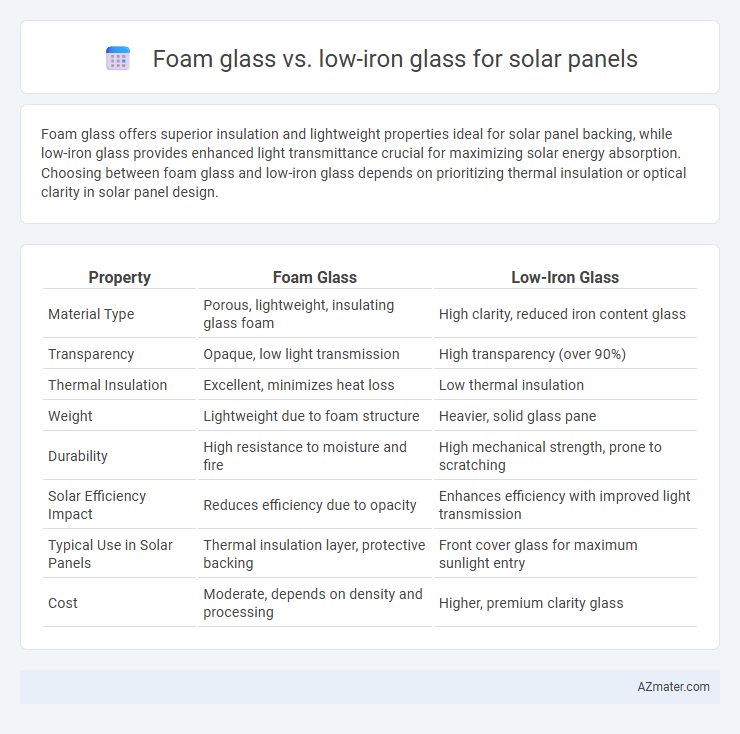Foam glass offers superior insulation and lightweight properties ideal for solar panel backing, while low-iron glass provides enhanced light transmittance crucial for maximizing solar energy absorption. Choosing between foam glass and low-iron glass depends on prioritizing thermal insulation or optical clarity in solar panel design.
Table of Comparison
| Property | Foam Glass | Low-Iron Glass |
|---|---|---|
| Material Type | Porous, lightweight, insulating glass foam | High clarity, reduced iron content glass |
| Transparency | Opaque, low light transmission | High transparency (over 90%) |
| Thermal Insulation | Excellent, minimizes heat loss | Low thermal insulation |
| Weight | Lightweight due to foam structure | Heavier, solid glass pane |
| Durability | High resistance to moisture and fire | High mechanical strength, prone to scratching |
| Solar Efficiency Impact | Reduces efficiency due to opacity | Enhances efficiency with improved light transmission |
| Typical Use in Solar Panels | Thermal insulation layer, protective backing | Front cover glass for maximum sunlight entry |
| Cost | Moderate, depends on density and processing | Higher, premium clarity glass |
Introduction: Foam Glass vs Low-Iron Glass in Solar Panels
Foam glass offers exceptional thermal insulation and durability, making it an effective substrate for solar panels in harsh environments. Low-iron glass enhances solar panel efficiency by maximizing light transmission and reducing iron-induced green tint, thus improving energy output. Comparing foam glass and low-iron glass highlights the trade-off between insulation properties and optical performance essential for optimized solar panel design.
Material Composition and Manufacturing Processes
Foam glass consists primarily of recycled glass and foaming agents, creating a lightweight, porous structure through a high-temperature sintering process that traps gas bubbles, enhancing insulation and durability. Low-iron glass, typically made from purified silica with reduced iron oxide content, undergoes a float glass manufacturing method to eliminate green tint and maximize light transmittance for solar panel efficiency. The material composition and manufacturing of foam glass emphasize superior thermal insulation and mechanical strength, whereas low-iron glass prioritizes optical clarity and photovoltaic performance.
Optical Properties and Light Transmission
Foam glass exhibits lower light transmission compared to low-iron glass, typically allowing around 60-70% of solar irradiance to pass through, which can reduce overall solar panel efficiency. Low-iron glass offers superior optical clarity with light transmission rates exceeding 90%, enhancing solar energy absorption due to minimal iron content that reduces greenish tint and light absorption. The optical properties of low-iron glass make it the preferred choice for solar panel covers where maximum light transmission and minimal reflection are critical for optimal photovoltaic performance.
Thermal Insulation Capabilities
Foam glass offers superior thermal insulation capabilities compared to low-iron glass due to its closed-cell structure, which significantly reduces heat transfer and enhances energy efficiency in solar panels. Low-iron glass provides high transparency with minimal light absorption, optimizing solar energy capture but lacks substantial insulating properties. Choosing foam glass can improve the overall thermal performance of solar panels by minimizing heat loss, thereby maintaining panel temperature and efficiency in varying environmental conditions.
Mechanical Strength and Durability
Foam glass offers superior mechanical strength due to its cellular structure, providing enhanced impact resistance and compressive strength for solar panel applications. Low-iron glass, while highly transparent and efficient in light transmission, generally exhibits lower mechanical robustness compared to foam glass, making it more susceptible to damage under stress. The durability of foam glass ensures longer service life in harsh environmental conditions, whereas low-iron glass requires protective coatings or laminations to improve its resistance to scratches and breakage.
Weight and Structural Requirements
Foam glass is significantly lighter than low-iron glass, reducing the overall weight of solar panel installations and easing structural load requirements. Low-iron glass, while offering superior light transmission and durability, tends to be heavier, necessitating stronger support frameworks. Choosing foam glass can lead to cost savings in mounting and structural materials due to its lightweight nature, especially in large-scale solar arrays or rooftop installations with limited load capacities.
Environmental Impact and Sustainability
Foam glass offers superior environmental benefits through its use of recycled materials and exceptional thermal insulation, reducing energy consumption in solar panel systems. Low-iron glass provides enhanced solar transmittance and durability, improving overall panel efficiency but involves higher energy inputs in production. Choosing foam glass supports circular economy principles by minimizing waste, while low-iron glass optimizes energy yield, both contributing differently to sustainability in solar technology.
Installation and Maintenance Considerations
Foam glass offers superior insulation and durability, reducing thermal bridging and lowering maintenance frequency in solar panel installations. Low-iron glass enhances light transmittance for higher photovoltaic efficiency but requires careful handling due to its brittleness and susceptibility to chipping during installation. Choosing between foam glass's robust lifespan and low-iron glass's optical benefits depends on site conditions and long-term maintenance goals.
Cost Comparison and Economic Feasibility
Foam glass offers a cost-effective insulation option with lower raw material expenses and enhanced thermal performance compared to low-iron glass, which typically commands higher prices due to its purity and clarity benefits essential for solar efficiency. While low-iron glass maximizes energy yield by allowing more solar transmittance, its premium cost can impact the economic feasibility of large-scale solar panel projects, especially in budget-sensitive installations. Evaluating lifecycle costs reveals foam glass reduces overall expenditures through improved insulation and durability, making it a favorable choice where balancing upfront investment and long-term savings is critical.
Suitability and Performance in Solar Panel Applications
Foam glass offers excellent thermal insulation and durability, making it suitable for protecting solar panels in harsh environmental conditions, but it lacks the high optical clarity required for efficient light transmission. Low-iron glass is specifically optimized for solar panel applications due to its superior light transmittance and minimal iron content, enhancing solar energy absorption and overall panel performance. The choice between foam glass and low-iron glass hinges on balancing structural protection and maximum energy conversion efficiency in photovoltaic modules.

Infographic: Foam glass vs Low-iron glass for Solar panel
 azmater.com
azmater.com